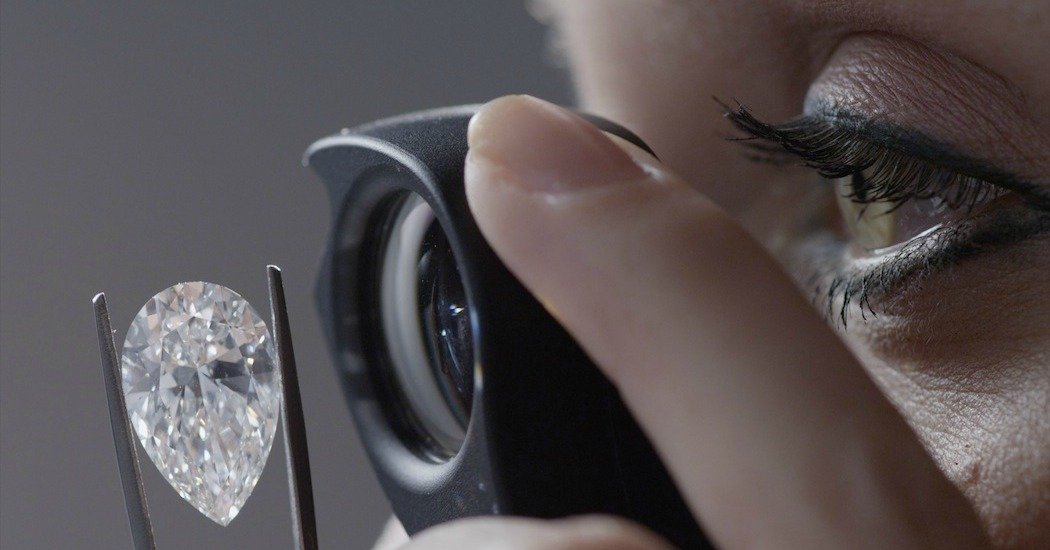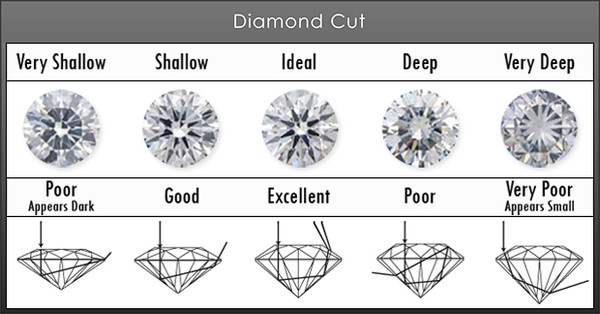
When you’re buying a diamond it’s important to strike a balance between the 4C’s; colour, clarity, cut and carat weight. Keep in mind that diamonds are scarce and you might run into situations where you have to pick one C over another;
- You’re in the market for a diamond shape that isn’t widely stocked and you have very limited diamonds to choose from. Asscher, emerald, marquise and heart shaped diamonds are the usually the culprits.
- You wish to optimise one C (probably carat weight/size) and need to know how low you can drop other Cs without compromising the appearance of the stone.
- You’re new to diamonds and need a starting point.
Very Important: The 5th C – Certification
It’s very important to understand that if diamonds aren’t properly graded comparing stone A to B is impossible unless you’re a diamond expert. Most buyers rely 100% on the integrity of a diamond grading certificate. In the image above you can see that a “G” grading differs substantially between the GIA and the EGL International.
Unfortunately the over-grading of diamonds has become a massive international problem. Although the diamond industry has taken a few steps in the right direction many jewellers are still selling diamonds that have been erroneously over-graded by local and international grading institutions.
Imagine two jewellers have the exact same uncertified diamond. One chooses to have it properly graded by the GIA and the other decides to use one of the more “lenient” labs – say EGL International.
GIA Report
- Weight: 0.70ct
- Colour: J
- Clarity: SI3
- Price: R17 500 (at 30% discount to Rapaport List)
EGL International Report
- Weight: 0.70ct
- Colour: H
- Clarity: SI2
- Price: R29 800 (at 30% discount to the Rapaport List)
*Remember these diamonds are identical. Carbon copies.
The main issue with over grading is that is it a material misrepresentation of the diamond. Even if the jeweller sells this EGL International graded diamond to you at a bargain price – it’s not a 0,70ct H SI2.
The Most Important Official C: Diamond Cut.

Diamond cut is often confused with the diamond shape (Round, oval, square).
A diamond has very special light reflection and refraction characteristics. You can think of a diamond’s facets (sides) as internal mirrors that reflect light internally to and from the diamond’s environment.
Through decades scientists have experimented with the optimal placement and proportions of diamond facets. The modern brilliant cuts have been designed to ensure that a diamond optimally reflects light when cut to these determined proportions and dimensions.
Through a series of complex measurements and comparisons a diamond grading laboratory determines how close a diamond has been cut to these “ideal” proportions. This grade is then referred to as the cut of a diamond;
- Excellent (Perfect)
- Very Good (Very close to perfect – indistinguishable from Excellent cut unless you’re a gemmologist)
- Good (Very broad grade. Some are fine some look terrible. Rather avoid).
- Fair (Avoid)
- Poor (Avoid)

You can have the highest known quality diamond – if it’s poorly cut it looks like nothing more than a dull piece of glass.
Imperfections in diamonds are also much more visible in poorly cut diamonds. When a diamond is properly cut the sparkle and life of the diamond easily masks minor imperfections. When it’s poorly cut – most specks and imperfections are visible.
There is never a reason to compromise on the integrity of diamond certification or the quality of the cut. No colour, size or clarity can save a poorly cut diamond.
My minimum recommended specifications for the other 3C’s.
Size matters and diamond size (carat) should be the next C on your mind.
Not everyone can muster up the courage to ask how low can you drop colour and clarity to optimise size without sacrificing the visual appeal of the diamond. So let me just put it out there;
If the diamond has been certified by the GIA and has medium to very strong blue fluorescence (this is indicated on the GIA certificate) you can drop the colour to L or M. If the diamond has no or faint fluorescence you should stick to K or better. This will ensure the diamond appears white when set into a ring. You can read about diamond fluorescence here.
Keep the clarity at SI2 or better. If you’re buying larger than a 1ct diamond draw the line at SI1. When buying SI-diamonds it’s very important to view the diamonds before you buy. Some SI2 imperfections might be visible to very, very sharp eyes.
What’s Important To You?
If there’s one thing I’ve learnt from selling diamonds every day for many years it’s this; every person is different and what’s important to one person might seem bizarre to another. We stock a broad range of GIA certified “Very Good” and “Excellent” cut diamonds so you can rest assured the foundation is rock solid. They’re all properly certified and the cut grade is more than adequate.
Whether you’re focussed on size, colour or clarity – I’ll assist in helping you choose the perfect diamond from our extensive offering.
Feel free to reach out on info@poggenpoel.com, call us on (012) 111 0525 or leave a comment below.
You can also browse our current diamond specials HERE.
Chat soon.
Johan Poggenpoel

